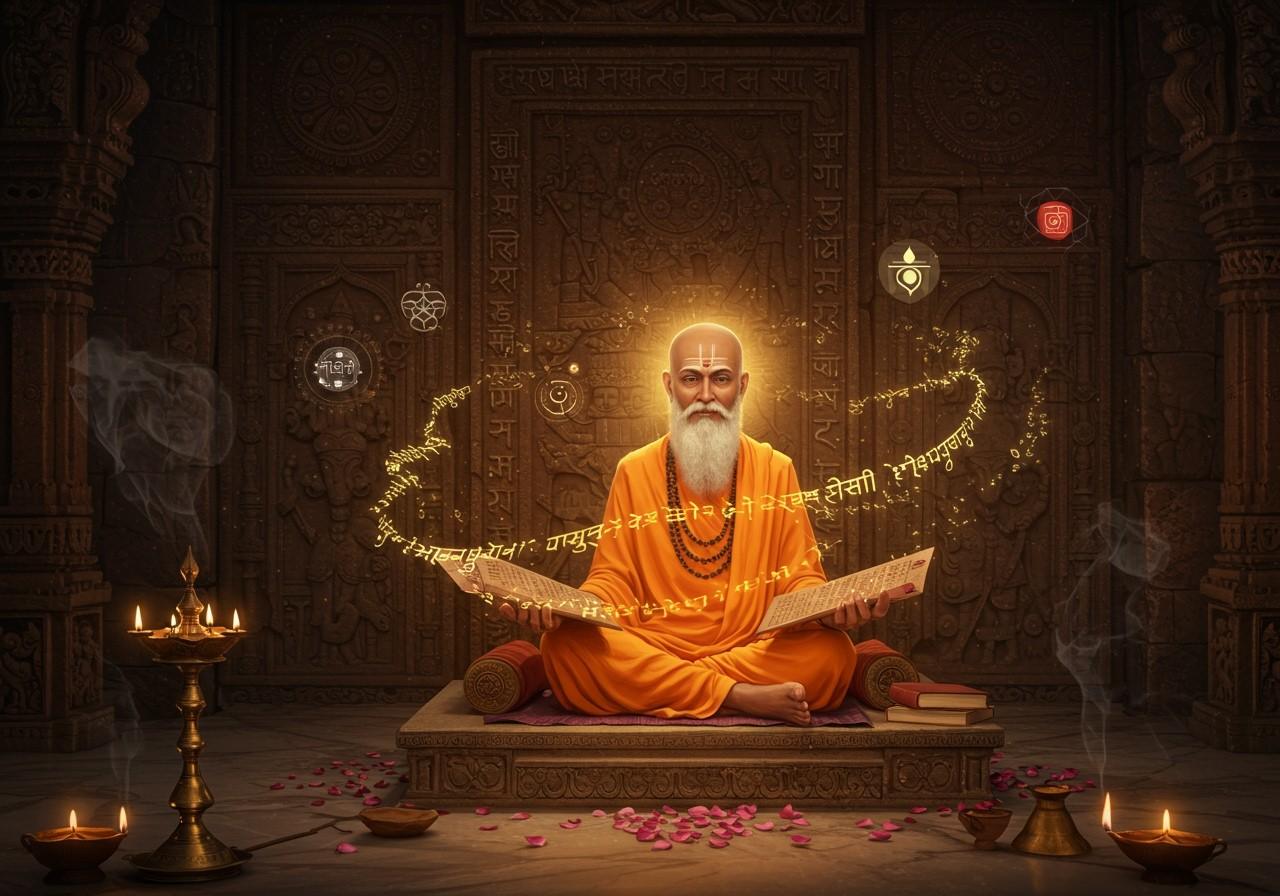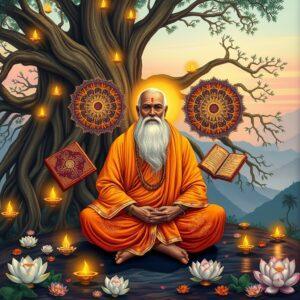
Kumārila Bhaṭṭa, a prominent Hindu philosopher of the Mimamsa school, flourished in India around the 7th century CE. Known for his staunch defense of Vedic injunctions, his work, particularly the Slokavārttika, has profoundly impacted ritualistic traditions. This blog explores Kumārila Bhaṭṭa’s life, his seminal work, and the continuing relevance of the Slokavārttika for those seeking authenticity and a deeper understanding of Vedic practices.
Who was Kumārila Bhaṭṭa?
Kumārila Bhaṭṭa, a renowned scholar of early medieval India (around the 7th century CE), was a key figure in the Mimamsa school of philosophy. His deep-rooted Vedic education shaped his intellectual journey, leading him to become a staunch advocate for Vedic authority. He robustly defended Vedic rituals against rival schools, particularly Buddhism, emphasizing the importance of preserving these traditions. His major works, including the Tantravārttika, Tuptīkā, and the Slokavārttika, remain essential texts for understanding Mimamsa.
Understanding the Slokavārttika
The Slokavārttika stands as a cornerstone of Mimamsa literature. This critical gloss delves deep into the Mimamsa Sutras of Jaimini, offering invaluable interpretations of Vedic rituals and philosophical concepts. Organized into chapters addressing key themes like Vedic authority, dharma, and the role of rituals, it provides a comprehensive framework for understanding the intricacies of Mimamsa. The text elucidates the nature of Vedic injunctions, emphasizing their autonomous nature (Svacchanda) and inherent validity (Svatah Pramanya). It also explores the concept of Arthavada, the explanatory statements within the Vedas that provide context and meaning to the injunctions.
Mimamsa Philosophy and Rituals
Mimamsa philosophy places central importance on the performance of Vedic rituals. Kumārila’s Slokavārttika serves as a practical guide, explaining the proper execution of these rituals and their philosophical underpinnings. It introduces the concept of Apurva, the unseen force generated by rituals that leads to future benefits. This concept provides a justification for the continued observance of traditional practices, highlighting their efficacy beyond the immediate visible realm. The Slokavārttika bridges the gap between theory and practice, enabling a deeper understanding and more meaningful engagement with Vedic rituals.
Kumārila Bhaṭṭa’s Enduring Influence
Kumārila Bhaṭṭa’s contributions to Indian philosophy extend far beyond his own time. His interpretations of the Vedas and his articulation of Mimamsa principles have influenced other schools of thought, including Vedanta and Nyaya. He played a pivotal role in the revival of Vedic authority during a period of intellectual ferment. Modern scholars continue to engage with his works, recognizing their enduring relevance for understanding the complexities of Indian philosophical traditions.
Key Concepts in the Slokavārttika
The Slokavārttika introduces several key concepts crucial for grasping Mimamsa philosophy:
- Svacchanda: This concept emphasizes the autonomous nature of Vedic injunctions, highlighting their inherent authority derived from the Vedas themselves.
- Svatah Pramanya: This principle asserts the self-evident validity of the Vedas, establishing them as the ultimate source of knowledge and truth.
- Arthavada: These explanatory passages within the Vedas provide context and meaning to the injunctions, enriching our understanding of their purpose and significance.
- Karma: The concept of Karma underscores the central role of actions in Mimamsa philosophy. Ritualistic actions, performed with proper understanding and intention, generate Apurva and contribute to spiritual growth.
Practical Applications of the Slokavārttika
The principles elucidated in the Slokavārttika offer practical guidance for contemporary practitioners of Vedic rituals. By studying this text, individuals can gain a deeper understanding of the meaning and purpose behind these practices. This understanding allows for a more mindful and authentic engagement with rituals, fostering a stronger connection to tradition. Resources like commentaries and scholarly works can further enhance one’s study of the Slokavārttika.
Poojn.in: Supporting Your Spiritual Journey
Enhance your study of the Slokavārttika and create a conducive environment for reflection with these offerings from Poojn.in:
- Brass Study Lamps: Illuminate your study space with the warm glow of traditional brass lamps, handcrafted by skilled artisans. Explore our collection of brass lamps.
- Meditation Seats: Maintain comfortable posture during long study sessions with our meditation cushions and wooden seats, available in various traditional designs. Find the perfect meditation seat.
- Copper Water Vessels: Adhere to ancient learning traditions by keeping water in pure, certified copper vessels while you study. Browse our copper vessels.
- Incense and Dhoop: Create a serene atmosphere with traditional fragrances like sandalwood and camphor. Discover our range of incense and dhoop.
- Book Stands: Support your texts with our specially designed wooden book stands, available in folding and fixed options. Choose a book stand that suits your needs.
Visit Poojn.in to explore our complete collection of study aids and ritual items. We offer secure packaging and delivery across India.
Conclusion
The Slokavārttika of Kumārila Bhaṭṭa remains a vital text for understanding Mimamsa philosophy and Vedic rituals. By engaging with this work, we can deepen our appreciation for these traditions and perform rituals with greater understanding and meaning. Kumārila Bhaṭṭa’s legacy continues to inspire both scholars and practitioners, ensuring the preservation and continued relevance of Vedic knowledge in the modern world.
Explore related articles on Hinduism and its rich traditions:
- Hinduism’s Global Reach
- Hinduism: A Complete History and Origin
- Connecting with Your Inner Self: A Hindu Philosophy Guide


